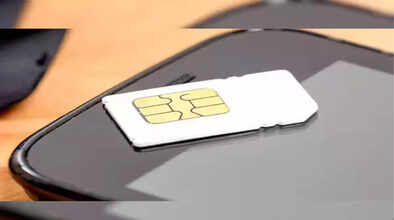SIM Card: Why is the corner of the SIM card cut? There is a big logic behind this which most people do not know..

We use so many things in our daily life, but never pay attention to their design. From the USB port to the buttons of your shirt, there is a special reason behind the design of everything. One such thing is the SIM card of our mobile.
You too must have inserted or removed a SIM card in your phone and must have seen that one corner of it is cut. But have you ever wondered why the SIM card design is like this? This is not just a style, but a very simple and great engineering principle is hidden behind it, which helps us and your mobile a lot. Let us know the big story behind this small cut today.
The design was not like this in the beginning.
The SIM with cut corners that we see today was not always like this. When mobile phones started, the design of the initial SIM card was very normal and square. At that time, it was very difficult for people to understand from which side the SIM should be inserted into the phone. Many people had difficulty identifying the upside-down and straight SIM cards. Many times, while trying to insert or remove the SIM card in the wrong way, the risk of damaging the SIM card chip or the SIM card slot increases. To overcome this problem of consumers, telecom companies and mobile manufacturers together thought of changing their design.
Why was the corner cut? This is the real reason.
TRENDING NOW The main reason behind cutting the corner of the SIM card is the 'Poka-Yoke' design principle. This is a Japanese term which means 'mistake-proofing'. The corner of the SIM card was cut and given a unique shape so that it could be inserted in only one way. When you look at the SIM tray of your phone, there is a similar cut on one corner in the place where the SIM is placed. This cut works like a guide. This one small change made the use of the Mobile SIM Card very easy for crores of people.
Not just for your convenience, security is also the reason.
This small cut is not just for convenience, but it also protects both your expensive phone and SIM card. The golden chip on the SIM card is very delicate. The phone reads the SIM through this chip. If you insert the SIM in the slot in the wrong way, then these golden contacts can rub against the internal pin of the phone in the wrong way, due to which there is a risk of damage to both the SIM and the phone. The cut corner ensures that the SIM is always inserted correctly and the contacts remain safe.
The size of the SIM changed with time.
With the development of technology, phones became thinner and smaller, and with that, the SIM card also changed. But one thing that did not change was the cut on the corner.
Mini SIM: This is the standard size SIM, which we have been using for a long time.
Micro SIM: This size became popular after the arrival of smartphones. It was smaller than the mini SIM, but it also had a cut corner.
Nano SIM: This SIM is used in most of today's smartphones. It is the smallest physical SIM, but its identity i.e. the cut corner design, is still intact.
Now is the era of eSIM, is the story of physical SIM coming to an end?
Today, technology has advanced further, and now the era of eSIM (Embedded SIM) has arrived. It is a virtual SIM that is directly embedded in the motherboard of the phone. For this, you do not need to insert any physical card in the phone. Because there is no physical card in it, the question of its design or cut corners does not arise. In the future, it is possible that physical SIMs may end completely, and with them, this 'cut corner' design will also become history.
Summary
In short, one corner of the SIM card is cut so that users cannot insert it in the phone in the wrong way. This is a 'mistake-proofing' design that ensures that the SIM is always inserted in the right direction. Not only does this make inserting the SIM easier, it also protects the SIM chip and the phone slot from potential damage. This small cut is a great example of engineering, showing how a simple change can improve the experience of millions of people.
Disclaimer: This content has been sourced and edited from Zee Business. While we have made modifications for clarity and presentation, the original content belongs to its respective authors and website. We do not claim ownership of the content.

